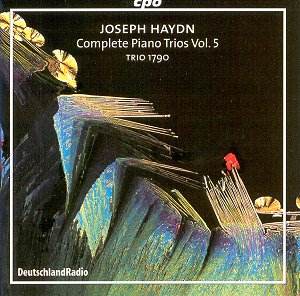The Trios for keyboard, violin and cello take
a prominent position in the musical output of Haydn. Strangely
enough there are not many recordings of these trios available,
at least not complete recordings. And there is only one complete
recording on period instruments, by Patrick Cohen, Erich Höbarth
and Christophe Coin (Harmonia Mundi France), although they have
not recorded the last two trios of this CD.
This is Volume 5 of the recording of all Haydn’s
‘piano trios’, and presumably the last in the series. It contains
three trios that Haydn composed in the first half of the 1790s,
first and foremost for the English market. In this light I would
have preferred the use of an English fortepiano instead of the
copy of an instrument by the German Matthäus Heilmann.
The ‘piano trio’ has its roots in the trio sonata
of the baroque. Haydn’s earliest trios give ample evidence of
that. But in these late trios the keyboard takes the main role.
The trios were usually described as ‘sonatas’ and Haydn preferred
to call them ‘Clavier Sonatas’. The violin and cello have an accompanying
role. The last trio on this disc (H XV 32) even exists in a version
for keyboard and violin, and it is still unclear whether the cello
part in the publication of 1794 by the Preston publishing company
is authentic.
The character of these trios varies. Of the first
group of three (H XV 24-26) the one in G is perhaps the best known
and most popular, in particular because of the ‘Rondo al’Ongarese’,
called ‘Rondo in the Gipsies’ style’ in the first edition. The
trio in f sharp minor, on the other hand, is a much more serious
and profound composition. The Trio in e flat minor is another
one in a rare key. This work wasn’t conceived as a unity, but
after Haydn returned from England in 1795 he decided to compose
an Andante to an Allegro he had composed while in England. The
nickname in the manuscript refers to the biblical story of Jacob,
seeing a ladder in his dreams, with angels ascending and descending.
It was written anonymously for a German amateur violinist in England,
who had problems with the highest notes. So Haydn, with his typical
wicked sense of humour, sent him a piece where he had to go up
and down all the time. It caused him great trouble, and the violinist
"cursed the unknown composer", according to Haydn’s
biographer Dies.
On the whole this is a good and commendable recording.
The ensemble playing is excellent, and there is no lack in expression
in the more serious pieces. It is the lighter stuff that lacks
some sparkle. The ‘Rondo al’Ongharese’ is played very fast, but
doesn’t sound really playful. I would have liked somewhat stronger
accents, here but also elsewhere.
I am not always satisfied with the tempi. The
andante from the Trio in D (H XV 24) is too slow, certainly in
comparison with the andante from the next Trio (H XV 25). And
the allegro from the Trio in G (H XV 32) could have been a little
faster too. The Trio in f sharp minor is definitely the highlight
of this recording, and ‘Jacob’s dream’ doesn’t give the violinist
the problems her poor colleague in the 1790s encountered.
Johan van Veen
